When a person has decided to go into the business of raising goats after researching the other factors, which stand to affect the success of their operation, consideration must be given to containing the animals. Goats are one of the more difficult species of livestock to contain. The natural curiosity and inquisitive nature must be considered. An effective fence that will safely and effectively contain goats in their designated area over the long term is an important factor in fence construction.
The costs of construction must be taken into consideration. In most situations the perimeter fences of a property will be of a permanent nature. Division and cross fences lend themselves to adjustable modes of construction. There are many fencing material and construction options available, and some will be mentioned in terms of their effectiveness.
Conventional fencing
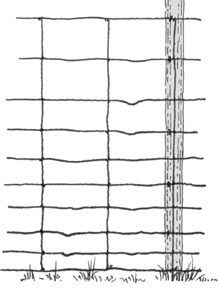
The conventional fencing for goats is a fence constructed of net, woven, or mesh wire. The work skills required to build a suitable net wire fence are greater than those required for other types; however, the expected service life of a net wire fence is longer than that of other types of fencing. Construction cost, are higher due to the materials needed and the time required for construction.
Variables to be taken into consideration are materials cost, and construction skills of the producer. Consideration may be given to the availability of local fencing contractors and their rates. Conventional fences are generally permanent so extensive planning needs to go into their route and location prior to starting construction.
Guidelines and materials for constructing conventional fencing
Wood, steel pipe, or T-posts may be used for the construction of the corner H-braces, line or stretch braces, and for line posts, respectively. Materials, which are available in the producer’s home area at the most economical cost, should be considered. Producers may have access to resources such as timber they might harvest for posts, or possibly pipe available for use as fence posts at salvage rates on their property. Staples for attaching wire to wooden posts, and tie wire or pre-formed clips to attach the net to steel posts are also needed.
Permanent corner braces should be of the H-brace type of construction. Additional bracing in the form of a “jake leg” or angle brace may be used for greater strength. A minimum post installation depth of 30 inches is recommended in dirt holes, and a 12 inch minimum post hole depth when building fencing in rock is recommended. When building in rocky areas where digging depth is limited the use of concrete to securely anchor the post is recommended.
Permanent corner brace

Stretch braces will be needed at regular intervals on longer sections of a fence line. A good guideline is to set a brace for each 990’ (3 X 330’ rolls), or at 1320’ (4 X 330’ rolls) maximum. On shorter sections of a fence line, the corner braces will provide sufficient strength. Stretch braces of the “A brace” type of construction can be used. The purpose of a stretch brace is to relieve strain on corner braces on these longer stretches of fencing. As with the corner braces, a minimum post installation depth of 30 inches is recommended in dirt. When building in solid rock, this depth may be reduced to as little as one foot provided the post is securely anchored.
Line posts will need to be set at regular intervals in order to support the net wire between the corner braces. They are also needed between the stretch braces on the longer sections of a fence line. Post spacing and the material used for the posts will depend upon the desired strength and purpose of the fence. Wood or pipe line posts set at 60 foot intervals, with T-posts for support set at 15 or 20 foot intervals will be adequate under most conditions.
Woven or mesh wire
The type of woven or mesh wire to be used in construction, whether regular or high tensile, is another consideration. Regular steel woven wire is of sufficient strength under most conditions. The high tensile woven wire now available, in addition to being stronger, has a thicker galvanized coating. High tensile net wire normally comes with a Class III galvanized coating compared to a Class I for regular steel net wire. In high rainfall areas, areas in close proximity to salt water, or where heavy mineralized soils occur, the additional cost of high tensile net wire may be justified due to its durability.
The height of the mesh wire and the spacing of the vertical stay wires are important factors to consider. It is accepted that a fence of 48” in height will contain goats except under extreme circumstances. For horned goats, a 12” vertical stay wire spacing is preferred to a 6” stay wire spacing. The wider spacing allows a goat the opportunity to work its head and free its horns after putting them through the net. The 6” stay wire spacing used in some net wire has the capability catch the horns and trap a goat.
Woven wire classification and identification is simple once a producer understands the numbers present on the tag of a roll of wire. As an example consider a tag with the numbers 11-47-6-9. The first number, “11”, designates the number of horizontal wires on the net. The second number designates the height of the wire in inches; “47” means the wire is 47 inches tall. The third number designates spacing of the vertical or stay wires. In this example, the “6” means six inch spacing between stay wires. The last number on the tag designates the gauge or thickness of the wire. In this instance “9” means the net is constructed of nine gauge wire.
Net wire comes with expansion kinks on each horizontal wire between the vertical wires. Stretching the wire to the point of flattening out of the kinks to approximately 2/3 of their original height provides adequate tension. The purpose of these expansion kinks is to provide for expansion and contraction during periods of cold or hot weather. Tightening of the mesh to the point where these kinks are completely straightened out is not recommended.
Expansion kink
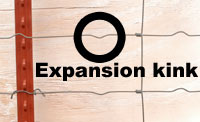
8- to 10-strand barbed wire fenceM/strong>
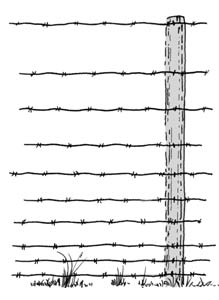
Another type of non-electric fence, which may appeal to some producers, is an 8 to 10 strand barbed wire fence. This type of fence uses individual strands of barbed wire spaced in a graduated manner with the bottom strands being closer together than the top strands. The bottom strand is placed 3 inches above ground level. The second strand is placed 4 inches above. The third strand is place 4 more inches up with the fourth strand placed 4 inches above the third. The next two strands (fifth and sixth) are set on 5 inch spacing. The seventh strand is set at 6 inches above the sixth with the top two wires (eighth and ninth) set at 8 inch spacing. This provides a nine-strand barbed wire fence with bottom wire spacing close enough to hold in kid goats and the recommended 47 inches in height.
One of the advantages of this type of fence is that barbed wire normally comes in 80-rod rolls whereas net wire comes in 20-rod rolls. One rod equals 16.5 feet meaning the barbed wire rolls are 1320 feet in length and the net wire rolls 330 feet in length. Thus, with barded wire, there are no splices in a quarter mile length. In comparison, three splices will be needed to create a quarter mile (1320’) of net wire. Using barbed wire reduces construction time since some wire splices are eliminated. Wire costs normally run less for the multi-strand barbed wire fence than mesh or net wire, but the need to stretch and tie each individual strand remains. Producers again have the option of using wire constructed of either regular or high tensile steel. The high tensile steel barbed wire provides greater strength, and when properly stretched, needs less work to maintain since it does not loosen up and sag over time as will the softer steel wire.
The same key construction components used for net or woven wire are needed for barbed wire fences, i.e., strong corner braces, stretch braces, line posts, and support posts between the line posts. These may already be in place along with 3 to 5 strands of existing barbed wire if the property had previously been used for livestock production, typically cattle. This existing fence will serve to further reduce construction cost, as 30 to 50% of the wire needed may already be in place. As a caution, if equine animals are to be housed on the same property with goats, the use of this type of fencing is not recommended.
Electric fencing
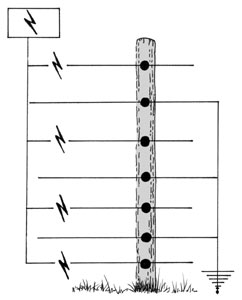
The least expensive and most portable type of fencing used for goats is electric fencing. This type of fencing lends itself particularly well to interior fences. Sturdy corner or stretch braces of similar construction to those used for conventional fencing are essential to bear the tension placed on the wire. Line posts for electric fencing may be placed at longer intervals than other fencing and are often constructed of materials whose cost is considerably less than the T-posts or wood posts used in net wire or multi-strand barbed wire fences. Steel T-posts with insulators or fiberglass rod posts, are the most commonly used line posts. Wooden battens are sometimes used for supporting the wires between the wooden line posts.
When fence portability is a consideration, step-in poly posts are commonly used. Ease of installation and removal for moving fences are two main advantages of these posts. A main reason for using a movable fencing system is to more effectively graze selected areas of a property. The ability to set up a strip or cell grazing system is easier with this type of fencing. Other advantages of a movable fence are the ability to defer grazing on certain sections of a property to allow for re-growth of forage, and to control the concentration of animals in brushy areas to reduce vegetation density. Electric fencing does require regular checks with a voltage meter to be sure that adequate current is flowing through the wires. Heavy vegetation growth contacting the hot wires can interfere with voltage transfer along the electric fence rendering it ineffective. Thus, vegetation control along the fence line is more of a consideration with electric fencing than with the net or barbed wire fences.
Another type of electric fence that serves well in some situations is a “roll-up” type of electric net fencing that comes with posts in one package. It is primarily used is when a high concentration of animals is needed in heavy grazing situations, or as a temporary holding pen for contract grazers. The cost of this pre-packaged fence is considerably higher than most other types of fence. It does, however, fit situations where portability is of more importance than permanence.
Training goats to an electric fence
Animals that have not been exposed to electric fencing will require a training period to become familiar with the consequence of touching the electric fence. Shiny objects attached to the wires arouse a goat’s natural curiosity causing them to investigate the fence. Some producers feed near an electric fence. An additional form of training is moving goats in a slow and gentle manner until they come into contact with the charged wires. In most cases, one or two contacts with an electrified wire will instill respect within the animals and cause future avoidance of this type of fencing.
The number of wires used in most electric fences varies from a 3- to a 7-wire system. A 5-wire system creates a more effective barrier for animals unfamiliar with electric fencing. A 3-wire system could be used with trained animals. Once goats have become familiar with electric fencing a single hot wire fence placed approximately 24 inches off the ground may serve as an effective containment barrier for adult animals.
For trained goats, electric fences are a cheap and effective alternative to the more expensive net or barbed wire fences. Keep in mind though that an electric fence creates more of a psychological than physical barrier. In times of fear, or when heavily pressured, goats may pass through an electrified fence
Converting existing cattle fence to a goat containment fence
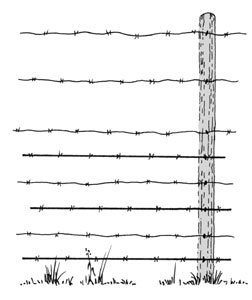
Many farms or ranches have existing fences that were designed to hold cattle. These may be either 3- or 5-strand barbed wire or electric fence. The adaptation of these existing fences into a fence that will contain goats is a simple procedure. The beauty of this situation is that the necessary corner braces, line posts, and stretch braces are already in place eliminating much of the labor involved in comparison to new fence construction.
The simple addition of a few more strands of barbed wire at appropriate spacing will quickly solve the problem at less than one-fourth the cost of constructing a new fence. Another alternative is to use “stand outs” attached to existing fence posts to build a combination conventional/barbed wire and electric fence. Stand outs are “V”-shaped, heavy gauge wire devices with an insulator at the apex or point of the “V”. Stand outs may be attached to either wire or posts, and provide a non-grounded means of supporting a strand of electric fencing wire. A producer may also use this add more strands of wire to adapt an existing electric cattle fence to create a “goat proof” fence.
Stand out
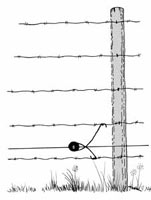
Equipment needed for fence installation
The equipment needed for construction, repair and installation of goat fencing is not an extensive list. The purchase or lease of equipment and tools listed below are recommended as necessary for ease of installation. Special tools are often required when working with high tensile wire. These tools may seem non-essential, but they will often make working with high tensile wire easier and much less frustrating.
- A powered posthole digger will make digging the holes for corners and brace posts an easier proposition. These holes can be dug by hand but much more sweat equity and time will be required. With a mechanical digger each hole will be the same diameter and depth. A variety of different diameter augers are available making it easy to select one for the size of posts being set. If the fencing is to be constructed in rock, then an air compressor and a rock drill or jackhammer will be needed to excavate the holes. As with the mechanical, auger-type diggers there are differing size bits for rock drills allowing a producer to choose the most appropriate size for the posts to be set.
- Important hand tools include a good pair of fencing or linesman pliers to cut and twist tie wire and assist in making splices, a hammer to drive fencing staples into wooden posts, and a commercial or homemade T-post driver. Do not use a sledgehammer to drive T-posts into the ground as it can lead to personal injury.
- If using wooden posts a chainsaw or hand saw will be useful in constructing braces. If working with pipe post, a cutting torch, cutoff wheel, and welding machine are needed equipment.
- Stretching equipment of some type is needed for net or barbed wire since they do not utilize permanently installed line tensioners. In order to achieve proper wire tension, a stretcher bar of commercial or homemade design is recommended for net wire. A regular two-ton pull “Come-along” will provide sufficient tension for stretches up to 1320’ long. One “Come-along” will work for barbed wire or single strand high tensile electric fence wire. When stretching net wire, it is recommended that one stretcher be attached at the top and one at the bottom to allow for more even tensioning of the wire.
Come-along

- For an electric fence, a good voltmeter ($50 – $60) will be needed to check the voltage and allow for trouble-shooting. Other supplies for an electric fence include, post insulators of some type, and a fence energizer of sufficient strength to maintain adequate current flow. Comparing the output of various energizers on the market is not a simple matter. The key unit for measuring output or “shocking power” is called a joule. The other tools needed for electric fence construction would be similar to those required for any other fence.
Hand-held voltmeter
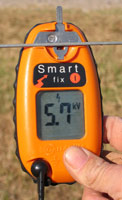
Solar-powered fence charger
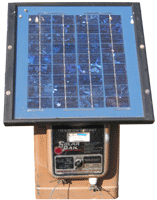
Next
Module Home
Certification Table of Contents
Browsing Table of Contents
